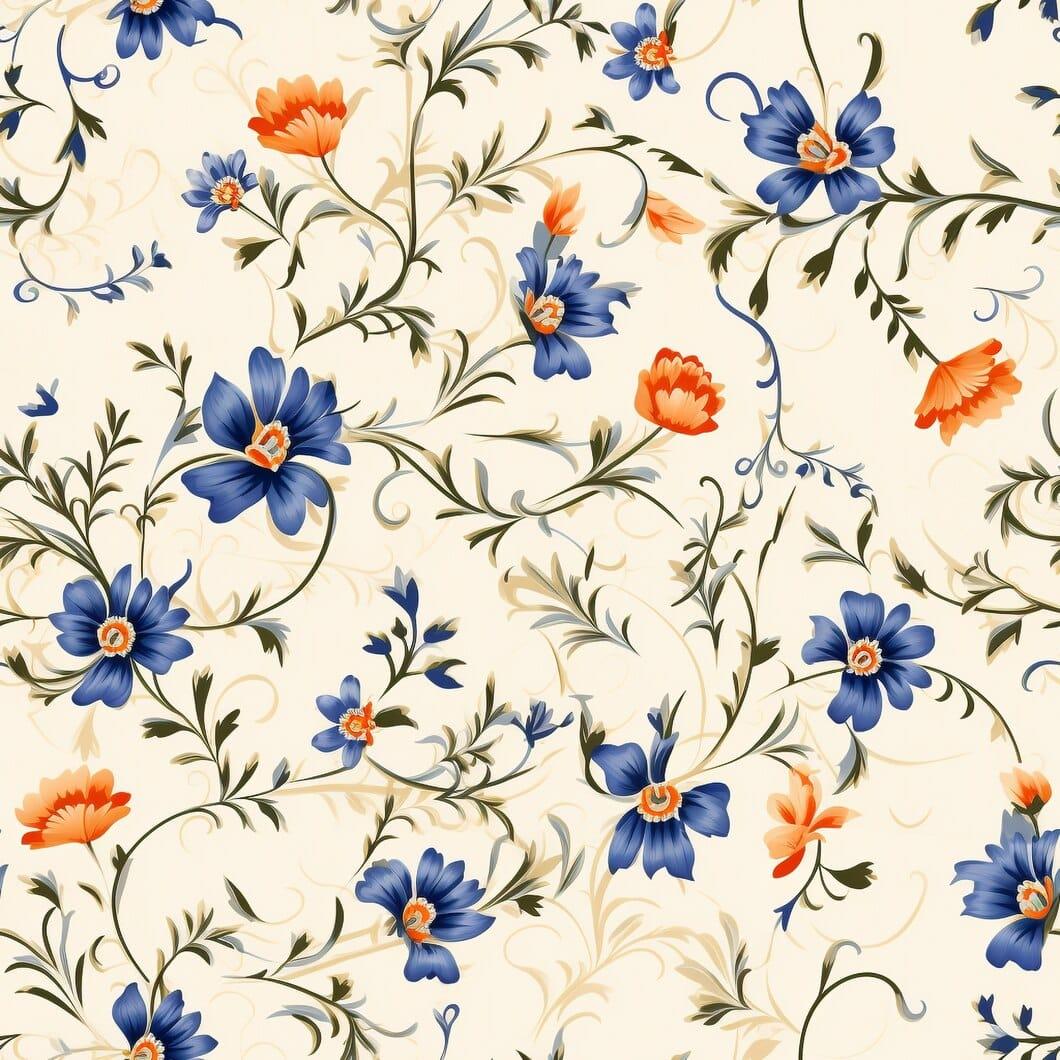The Timeless Elegance of Chintz
From palace walls to runway halls, discover how chintz's blooming patterns have woven their way through history, sparking bans and revivals alike. Unravel the allure of this timeless fabric!

Chintz, with its delicate floral patterns and rich history, has been captivating interior design enthusiasts and fashion lovers for centuries. This comprehensive guide delves into the world of chintz, exploring its intricate patterns, cultural significance, origins, aesthetics, and the ongoing debate about its timeless appeal. Join us as we uncover the allure of this timeless fabric.
Exploring the World of Chintz
Chintz, historically known for its beautiful floral motifs, offers a glimpse into the intricate craftsmanship of textile design. The delicate patterns found on chintz fabrics are a result of meticulous production techniques, bringing together a vibrant palette of colors and intricate details.
Unveiling the Intricate Patterns of Chintz
The beauty of chintz lies in its intricate patterns, each telling a story of its own. From blooming roses to exotic birds, chintz fabrics often feature nature-inspired motifs that evoke a sense of elegance and sophistication. The skillful combination of vibrant colors and detailed illustrations breathes life into these fabrics, making them a true work of art.
But what makes these patterns truly fascinating is their historical and cultural significance. Each motif carries its unique symbolism and meaning, making chintz an intriguing canvas for cultural exploration. For example, the rose motif, commonly found in chintz fabrics, symbolizes love and beauty in many cultures. It represents passion and desire, adding a touch of romance to any space adorned with chintz.
The Cultural Significance of Chintz
Chintz holds a deep-rooted cultural significance across various societies. From the opulent palaces of India to the refined interiors of English country homes, chintz has had a lasting impact on interior design and fashion.

Originating in India during the 17th century, chintz quickly became a symbol of luxury and exclusivity. Its delicate patterns and vivid colors were highly sought after by European nobility, who considered chintz fabrics a status symbol in their palaces and country estates.
However, the journey of chintz did not end there. As it found its way to England and other parts of Europe, it captured the imagination of designers and craftsmen alike. Its integration into European fashion and interior design led to a fusion of styles, creating a unique cross-cultural aesthetic that continues to inspire designers to this day.
Chintz's influence on interior design can be seen in the grand English country homes, where it adorns curtains, upholstery, and even walls. Its vibrant colors and intricate patterns add a touch of elegance and opulence to any space, creating a sense of timeless beauty.
Furthermore, chintz has also made its mark in the world of fashion. Designers have embraced the beauty of chintz fabrics, incorporating them into garments that exude grace and sophistication. From flowing dresses to tailored suits, chintz has become synonymous with style and luxury.
As we delve deeper into the world of chintz, we uncover not only its visual allure but also its rich cultural heritage. It is a testament to the skill and creativity of textile artisans throughout history, and a reminder of the enduring beauty that can be found in the intricate patterns of chintz fabrics.
Decoding the Origins of Chintz
In order to truly appreciate the beauty and significance of chintz, it is essential to understand its rich history and evolution through time.
Chintz, with its vibrant patterns and intricate designs, has a captivating story that spans centuries. Its origins can be traced back to ancient India, where skilled artisans hand-painted fabrics using natural dyes. These early chintz fabrics were not only visually stunning but also known for their exceptional durability.

As the demand for chintz grew, so did the need for more efficient production methods. This led to a revolutionary innovation in the form of block printing. By using intricately carved wooden blocks, artisans were able to transfer patterns onto the fabric with precision and speed. This breakthrough allowed chintz fabrics to be produced in larger quantities, making them more accessible to a wider audience.
The Evolution of Chintz Through History
The evolution of chintz did not stop there. As trade routes expanded and cultural exchanges flourished, chintz made its way to Europe. It quickly captured the imagination of European designers and became a sought-after luxury item. The vibrant colors and exotic motifs of chintz brought a touch of the East to Western interiors, creating a sensation in the world of fashion and design.
In response to the growing popularity of chintz, European manufacturers began experimenting with different techniques to recreate the hand-painted look of the original Indian fabrics. They developed innovative methods such as roller printing, which allowed for even more intricate and detailed patterns to be produced. This marked a new chapter in the history of chintz, as it continued to evolve and adapt to the changing tastes and demands of the market.
Chintz vs. Calico: Understanding the Differences
While chintz and calico are often used interchangeably, there are subtle distinctions between the two. While both fabrics feature vibrant patterns, the key difference lies in the production process.
Chintz, with its glazed finish, exudes a luxurious sheen that sets it apart. This distinctive characteristic is achieved by applying a resin-like substance to the fabric, enhancing the vibrancy of the colors and giving chintz its unmistakable allure. On the other hand, calico refers to unglazed, cotton fabrics featuring lively patterns. It has a more understated charm, with a natural and soft feel.

Furthermore, calico traditionally encompassed a broader range of motifs and styles, reflecting the diverse cultural influences that shaped its development. Chintz, on the other hand, focused more on intricate floral designs, capturing the essence of nature's beauty in every thread.
Understanding the differences between chintz and calico allows us to appreciate the unique qualities of each fabric. Both have their own distinct charm and historical significance, adding depth and variety to the world of textiles.
Aesthetics of Chintz: Patterns and Users
Chintz, with its timeless appeal, has remained a favorite choice for interior designers and fashion enthusiasts throughout the years. Let's explore how chintz patterns are utilized in contemporary settings and who embraces this elegant fabric.
Chintz in Contemporary Interior Design
In recent years, chintz has experienced a resurgence in interior design trends. Designers are embracing its nostalgic charm and incorporating chintz fabrics into various elements of a space, including upholstery, draperies, and wallpaper patterns.
One of the reasons for chintz's popularity in contemporary interior design is its ability to add depth and character to a space. The intricate patterns and vibrant colors of chintz fabrics can create a focal point in a room, drawing the eye and creating a sense of visual interest. Whether used as an accent piece or as the main fabric in a room, chintz has the power to transform any space into a delightful, romantic retreat.
Furthermore, chintz can be used to bridge the gap between different design styles. When used sparingly, it can add a pop of color and visual interest to a more minimalist or contemporary space, creating a harmonious blend of old and new. On the other hand, a room adorned in chintz exudes a sense of timeless elegance and warmth, making it a popular choice for those who appreciate classic design aesthetics.
Who Embraces Chintz in Fashion and Home Decor
Chintz has never lost its allure among fashion-forward individuals who appreciate its timeless appeal. It continues to grace runways and is celebrated by fashion designers for its versatility and ability to evoke a sense of nostalgia and femininity.
When it comes to home decor, chintz enthusiasts include those with a penchant for classic elegance, vintage charm, and even those seeking to add a touch of whimsy to their surroundings. With its vibrant patterns and soft textures, chintz offers a myriad of possibilities for personal expression through interior design.

From grand country estates to cozy urban apartments, chintz can find its place in any home. Its versatility allows it to seamlessly blend with different design styles, whether it's a traditional Victorian-inspired space or a modern eclectic interior. Chintz can be used to create a sense of continuity and cohesiveness in a room, tying together different elements and adding a touch of sophistication.
Moreover, chintz is not limited to specific rooms or areas within a home. It can be used in various ways, from upholstering chairs and sofas to creating statement draperies or even covering walls with chintz-patterned wallpaper. The possibilities are endless, and chintz offers a world of creative opportunities for those who dare to experiment.
Unraveling the Ban on Chintz in England
Chintz, despite its enduring popularity, faced a temporary ban in England during the late 17th and early 18th centuries. Let's explore the reasons behind this intriguing ban and how it shaped the perception of chintz in England.
The Resurgence of Chintz in Modern Design
With the cyclical nature of design trends, it is no surprise that chintz has once again found its place in contemporary interiors. Designers are reimagining chintz by incorporating it into modern and eclectic spaces, juxtaposing traditional patterns against sleek and minimalist backdrops.
Chintz today is no longer confined to a specific style or era; it has effortlessly adapted to various design sensibilities, making it a versatile choice for those seeking to infuse their spaces with character and personality.
Chintz: A Classic Revival in the 21st Century
As we enter a new era in design, chintz continues to prove its enduring appeal. With a renewed appreciation for craftsmanship and the desire for unique, personalized interiors, chintz has reemerged as a symbol of refined elegance and a celebration of the past.
Whether used in small doses or embraced fully throughout a space, chintz offers a timeless charm that goes beyond mere trends. It is a testament to the power of artistry and human creativity, reminding us of the lasting beauty of traditional crafts in our fast-paced modern world.
As you embrace the classic revival of chintz in your home or wardrobe, ensure you're making the most informed and economical choices with Spoken. Discover the best deals on chintz-inspired items without the hassle of comparing prices across different retailers. Check out products on Spoken and experience the ease of finding high-quality pieces at the best prices, all in one place. Let Spoken guide you to smart, stylish shopping that celebrates the beauty of chintz and the value of savvy shopping.
Quick facts
What was the ban on chintz?
The ban on chintz occurred in 18th-century Britain to protect domestic textile industries from cheaper Indian imports.
Is chintz outdated?
Chintz is not outdated; it has made a comeback in modern interiors, blending traditional patterns with contemporary designs.
What does chintz mean?
Chintz refers to a printed, multicolored cotton fabric with a glazed finish, often used for upholstery and curtains.
What is the difference between calico and chintz?
Calico is plain-woven cotton fabric, while chintz is a glazed, patterned version of calico, often with floral designs.
Is chintz coming back in style?
Yes, chintz is returning to style with updated patterns and fresh color palettes, making it popular in eclectic and modern traditional interiors.
Are Kalamkari and chintz the same?
Kalamkari and chintz are not the same. Kalamkari is a hand-painted or block-printed Indian fabric, while chintz refers to glazed, machine-printed textiles.

Mihai Crisan
Software Engineer at Spoken
Mihai is a dedicated software engineer at Spoken, where he combines his passion for technology with his professional expertise. As a tech geek, he is always on the lookout for innovative solutions to simplify and enhance people's lives through cutting-edge technology. Mihai’s curiosity drives him to explore and implement new ideas that make a real impact.
Read more